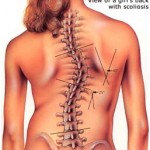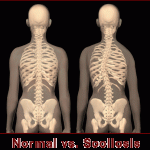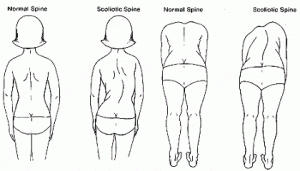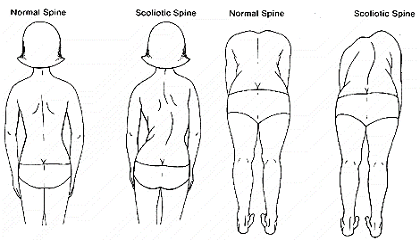The spine is an elegant structure. from the side it takes the form of an elongated s, the upper back bowing outward and the lower back curving slightly inward. your spine, or backbone, helps hold your body upright. Without it, you couldn’t walk, run, or play sports. If you look at yourself sideways in the mirror or look at a friend from the side, you’ll notice that the back isn’t flat like a piece of board. Instead, it curves in and out between your neck and lower back. some curvature in the neck, upper trunk and lower trunk is normal. However, when there are abnormal side-to-side (lateral) curves in the spinal column, we refer to this as functional scoliosis. Functional scoliosis is an abnormal curvature of the spine. While small curves generally do not cause problems, larger curves can cause discomfort. If a functional scoliosis curve gets worse, the spine will also rotate or twist, in addition to curving side to side. There are no activities, including sports, that doctors know about that can make functional scoliosis worse. A curved spine can cause someone’s body to tilt to the left or right. These problems may be noticed when a kid is trying on new clothes.
 If you have functional scoliosis, you’re not alone. the most common form of functional scoliosis, representing approximately 80% of idiopathic functional scoliosis cases, is adolescent idiopathic functional scoliosis (AIS), which develops in young adults around the onset of puberty. More girls than boys have severe functional scoliosis. Over 80% of functional scoliosis cases, however, are idiopathic, which means that there is no known cause. (Idiopathic is a fancy word for unknown cause.) Idiopathic functional scoliosis is broken down into four categories based on age: (1) infantile: children ages 3 and under, (2) juvenile: 3-9 years old, (3) adolescent: 10-18 years old, and (4) adult: after skeletal maturity.
If you have functional scoliosis, you’re not alone. the most common form of functional scoliosis, representing approximately 80% of idiopathic functional scoliosis cases, is adolescent idiopathic functional scoliosis (AIS), which develops in young adults around the onset of puberty. More girls than boys have severe functional scoliosis. Over 80% of functional scoliosis cases, however, are idiopathic, which means that there is no known cause. (Idiopathic is a fancy word for unknown cause.) Idiopathic functional scoliosis is broken down into four categories based on age: (1) infantile: children ages 3 and under, (2) juvenile: 3-9 years old, (3) adolescent: 10-18 years old, and (4) adult: after skeletal maturity.
 There are many causes of functional scoliosis, including congenital spine deformities, genetic conditions, neuromuscular problems and limb length inequality. Functional scoliosis runs in families, but doctors often don’t know the cause. Most types of functional scoliosis are more common in girls than boys, and girls with functional scoliosis are more likely to need treatment. other causes for functional scoliosis include cerebral palsy, spina bifida, muscular dystrophy, spinal muscular atrophy and tumors. Functional scoliosis is not a disease. It is a descriptive term. If a doctor says you have functional scoliosis, then the doctor and your parent can talk about whether treatment is necessary, and then talk to you about what happens next. You might get examined for functional scoliosis at school or during a doctor visit. In the united states, about half of the states require public schools to test for functional scoliosis. it involves bending over, with straight knees, and reaching your fingertips toward your feet or the floor. If the doctor wants to get a better look, he or she may order x-rays of your spine. The x-ray image to the right shows what functional scoliosis looks like. Sometimes the doctor will decide that the curve isn’t serious enough to need treatment.
There are many causes of functional scoliosis, including congenital spine deformities, genetic conditions, neuromuscular problems and limb length inequality. Functional scoliosis runs in families, but doctors often don’t know the cause. Most types of functional scoliosis are more common in girls than boys, and girls with functional scoliosis are more likely to need treatment. other causes for functional scoliosis include cerebral palsy, spina bifida, muscular dystrophy, spinal muscular atrophy and tumors. Functional scoliosis is not a disease. It is a descriptive term. If a doctor says you have functional scoliosis, then the doctor and your parent can talk about whether treatment is necessary, and then talk to you about what happens next. You might get examined for functional scoliosis at school or during a doctor visit. In the united states, about half of the states require public schools to test for functional scoliosis. it involves bending over, with straight knees, and reaching your fingertips toward your feet or the floor. If the doctor wants to get a better look, he or she may order x-rays of your spine. The x-ray image to the right shows what functional scoliosis looks like. Sometimes the doctor will decide that the curve isn’t serious enough to need treatment.
There are no activity restrictions for patients with functional scoliosis unless they have to have surgery. The metal parts are placed deep under the spine muscles, and in most cases can’t be felt and do not hurt. The surgeon also uses metal rods, hooks, screws, and wires to correct the curve and hold everything in line until the bones heal. The kid can usually go back to school about a month after surgery, then return to some activities in 3 or 4 months, and most normal activities after 6 to 12 months. A kid with functional scoliosis who has to have surgery should talk to a doctor about how to participate safely in activities.
 Before they used metal rods, a kid would have to wear a body cast for up to a year to keep the spine in place during the recovery period. A brace for functional scoliosis is meant to hold the spine in place so the curve doesn’t get any worse. This kind of brace comes up under the arms and is more comfortable than the bigger braces. No fun at all! Braces are meant to be used while the spine is still growing, especially when it grows very fast during the “adolescent growth spurt. ” After the spine finishes growing, braces are no longer effective. Therefore, a kid with functional scoliosis will spend less time in the brace as he or she gets older and gets closer to adult size. Over the years, the treatments have improved, so more and more kids with functional scoliosis live normal lives.
Before they used metal rods, a kid would have to wear a body cast for up to a year to keep the spine in place during the recovery period. A brace for functional scoliosis is meant to hold the spine in place so the curve doesn’t get any worse. This kind of brace comes up under the arms and is more comfortable than the bigger braces. No fun at all! Braces are meant to be used while the spine is still growing, especially when it grows very fast during the “adolescent growth spurt. ” After the spine finishes growing, braces are no longer effective. Therefore, a kid with functional scoliosis will spend less time in the brace as he or she gets older and gets closer to adult size. Over the years, the treatments have improved, so more and more kids with functional scoliosis live normal lives.
